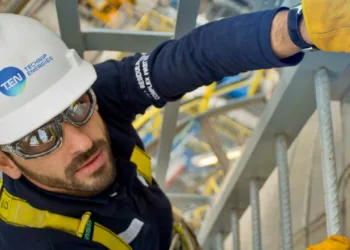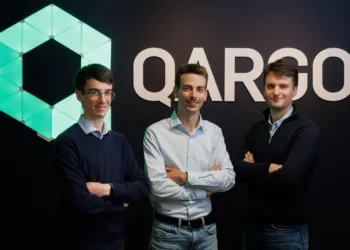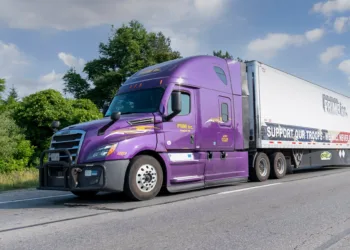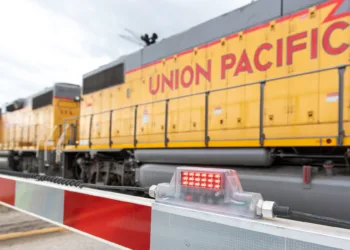Transitioning freight transport vehicles to cleaner technology remains costly but essential, industry and academic leaders said during a cross-border mobility panel on Thursday at the North American Development Bank’s (NADBank) 2025 summit in San Antonio.
The panel, “Driving Growth: Clean and Efficient Mobility Catalyzes Economic Integration,” featured voices from both sides of the U.S.-Mexico border, including Juan Baez of San Diego-based Bali Express Services.
“I believe that electrification is the way and Bali Express is committed to that ideal to make the company 100% sustainable by 2035, or 2040,” Baez said.
“What I like about electric trucks is that my operations team, my dispatchers, require that effort and dedication that focus to be a more efficient company, a company with a faster response with a more efficient route. We reduce costs, we reduce expenses, the client is more satisfied, so I think that adhering to new technologies is a challenge but it is possible, and it encourages you as a company to be better day by day.”
NADBank’s two-day annual summit included federal, state and municipal authorities, along with business organizations, academia, financial institutions, investors, project developers and experts, from both the U.S. and Mexico.
In addition to Baez, the panel also included Daniel Covarrubias of Texas A&M International University; Victor Salazar, chief commercial officer at Trayecto; and Jorge Gutierrez Topete, director of Baja California’s Institute of Sustainable Mobility.
Topete said the Mexican state of Baja California’s efforts to integrate sustainable practices into both freight and passenger transport emphasizes the importance of incentives over penalties in shifting fleets toward lower-emission technologies.
The Institute of Sustainable Mobility of Baja California promotes and develops a zero-emission mobility strategy for Baja California, as well as collaborating with U.S. programs across the border in the San Diego region.
“Incentives are always better than punishments, and that’s what we’re looking for: to find the economic model, because ultimately everything we’re going to talk about today is part of the economic model,” Gutierrez-Topete said, pointing to successful financing of Euro 6 clean-energy buses in Tijuana as a blueprint for scaling public and private fleet conversions.
“If the economic model doesn’t work, change won’t happen.”

In Texas, Covarrubias stressed the role of new infrastructure and research in preparing for a more sustainable border economy.
Covarrubias is the director of the Texas Center for Border Economic and Enterprise Development at the A.R. Sanchez School of Business at Texas A&M International University in Laredo, Texas.
With Laredo handling roughly 40% of U.S.-Mexico trade, Covarrubias urged for “smart borders” that integrate technology into new bridge projects.
“We’re talking about crossings between the U.S. and Mexico at the World Trade Bridge and the Colombia-Solidarity Bridge. You’re talking about 16,000 to 18,000 tractor-trailers crossing daily between the two countries,” Covarrubias said.
“We’re conducting the first and only pilot — a study on electric cargo vehicles, with the idea of being able to conceptualize what is the smart border entry? These new bridges, this new infrastructure on these new bridges, are they going to be the same as the ones we have now or do we have to reimagine them, rethink them based on technology? We have the unique opportunity for these bridges to be based on technology and change the process of being able to make those resources more efficient.”
Salazar shared Trayecto’s decade-long experiment with natural gas-powered trucks, which has grown from five units in 2015 to more than 600 today.
Trayecto is the biggest freight transportation company in Mexico. Trayecto, based in Monterrey, Mexico, has more than 4,000 trucks and 10,000 trailers.
“Currently, we make around 14,000 journeys per month between the different crossings,” Salazar said. “That’s a huge responsibility. We understand that we need to invest not only in the engines, which perhaps contribute most to reducing our carbon footprint, but also in water conservation initiatives.”
Salazar said Mexico lacks government incentives for green transport, pushing companies to find private solutions such as building their own fueling stations.
“All we want to do is have a positive impact on the cross-border community,” Salazar said, adding that Trayecto is also testing electric trucks despite range and charging challenges.
Baez highlighted Bali Express’s milestone as the first trucking company to operate electric Class 8 trucks across the U.S.-Mexico border, an initiative supported by NADBank financing.
The company has since launched a “green corridor” linking the Port of Long Beach with factories in Tijuana and San Diego, logging more than one million clean miles last year.
“We have to do it for the love of the planet,” Baez said, sharing that while electric trucks remain about 15 cents per mile more expensive than diesel, efficiency gains and smart routing are closing the gap.
Panelists agreed that a mix of technologies — including advanced diesel, natural gas, electric, and eventually hydrogen — will be needed to reduce emissions in North American freight. But they cautioned that without coordinated incentives, infrastructure, and investment, progress could stall.
“The air we breathe doesn’t recognize borders, and neither does the water we drink,” Topete said.
The post Border freight leaders bet on green tech at NADBank Summit appeared first on FreightWaves.























